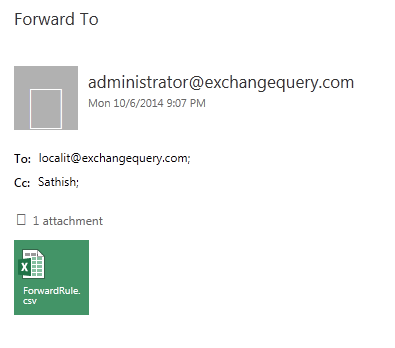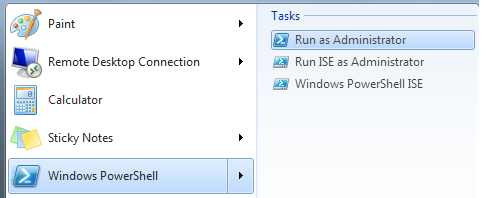One of the important task of the Exchange admin to assign the folder permission to the delegates, When new delegates added to the generic mailbox and Resource mailboxes. If the mailboxes has multiple folders and sub folders its time consuming process. The script simplifies the task and eliminates the manual errors
Browse to the folder and run the ps1 file, the initial screen looks below and select the option based on your action

***************************************************************************
<#
.SYNOPSIS
Add mailbox folder permission to the delegates for user and resource mailboxes
.DESCRIPTION
Important task of the Exchange admin to assign the folder permission to the delegates
when new delegates added to the generic mailbox and Resource mailboxes.
the script simplify the task and eliminate the manual errors
#>
Write-host ”
Assign Mailbox folder Permission
——————————–
1.Assign Folder permission to Single folder
2.Assign Folder Permission to All folders(includes user created,default,recoverable mailbox folders)
3.Assign Folder permission only to the default folders(inbox,calendar,….)
4.Assign Folder permission only to the user created folders
5.Exit ” -ForeGround “Cyan”
$option = Read-host “Choose the Option”
switch ($option)
{
1 {
$Mailbox = Read-Host “Enter Mailbox ID ”
$Folder = Read-Host “Enter the FOLDER NAME ( Examplles : Inbox,calendar…)”
$delegate = Read-Host “Enter Delegate ID ”
$Permission = Read-Host “Enter Type of Permission(Author, Editor, Owner, Reviewer, none)”
$foldername = $Mailbox + “:\” + $folder
If ($folder -ne “”)
{
Add-MailboxFolderPermission $foldername -User $delegate -AccessRights $Permission -confirm:$true
}
Else
{ Write-Host ” Please Enter Folder name ” -ForeGround “red”}
;break
}
2
{
$Mailbox = Read-Host “Enter Mailbox ID”
$delegate = Read-Host “Enter Delegate ID ”
$Permission = Read-Host “Enter Type of Permission(Author, Editor, Owner, Reviewer, none)”
$AllFolders = Get-MailboxFolderStatistics $Mailbox | Where { $_.FolderPath.ToLower().StartsWith(“/“) -eq $True }
ForEach($folder in $AllFolders)
{
$foldername = $Mailbox + “:” + $folder.FolderPath.Replace(“/”,”\”)
Add-MailboxFolderPermission $foldername -User $delegate -AccessRights $Permission -confirm:$true
}
;Break}
3 {
$Mailbox = Read-Host “Enter Mailbox ID”
$delegate = Read-Host “Enter Delegate ID ”
$Permission = Read-Host “Enter Type of Permission(Author, Editor, Owner, Reviewer, none)”
$Default = Get-MailboxFolderStatistics $mailbox | ?{$_.foldertype -ne “user created” -and $_.foldertype -ne “Recoverableitemsroot” -and $_.foldertype -ne “RecoverableItemsDeletions” -and $_.foldertype -ne “RecoverableItemspurges” -and $_.foldertype -ne “RecoverableItemsversions” -and $_.foldertype -ne “syncissues” -and $_.foldertype -ne “conflicts” -and $_.foldertype -ne “localfailures” -and $_.foldertype -ne “serverfailures” -and $_.foldertype -ne “RssSubscription” -and $_.foldertype -ne “JunkEmail” -and $_.foldertype -ne “CommunicatorHistory” -and $_.foldertype -ne “conversationactions”}
ForEach($folder in $default)
{
$foldername = $Mailbox + “:” + $folder.FolderPath.Replace(“/”,”\”)
Add-MailboxFolderPermission $foldername -User $delegate -AccessRights $Permission -confirm:$true
}
;break}
4 {
$Mailbox = Read-Host “Enter Mailbox ID”
$delegate = Read-Host “Enter Delegate ID ”
$Permission = Read-Host “Enter Type of Permission(Author, Editor, Owner, Reviewer, none)”
$Default = Get-MailboxFolderStatistics $mailbox | ?{$_.foldertype -eq “user created”}
ForEach($folder in $default)
{
$foldername = $Mailbox + “:” + $folder.FolderPath.Replace(“/”,”\”)
Add-MailboxFolderPermission $foldername -User $delegate -AccessRights $Permission -confirm:$true
}
;break}
5 {
}
}
************************************************************************
copy above code and save it as ps1 as extension(addmailboxfolderperm.ps1)




























